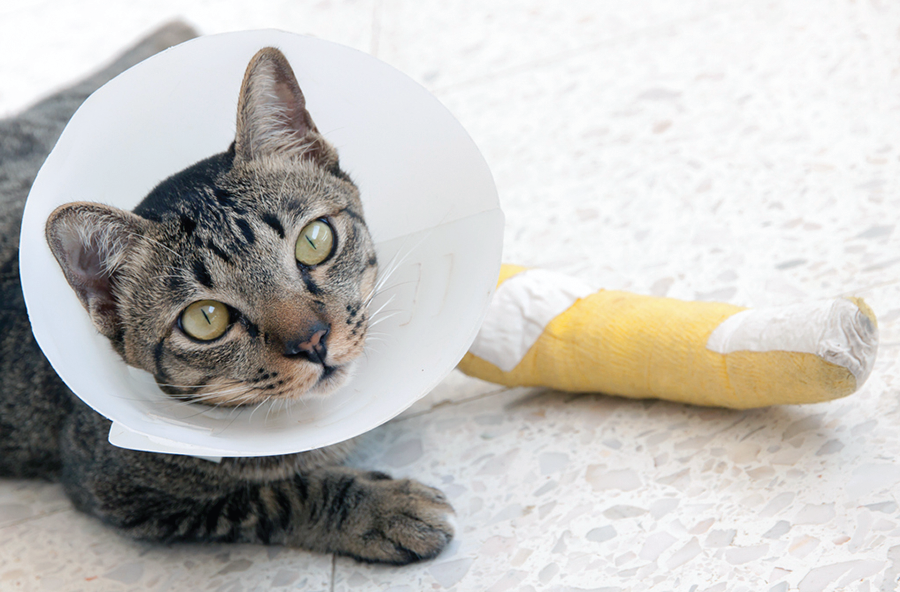Fractures happen in cats and kittens, even if they stay indoors. Falls from high areas, getting stepped on, or being crushed in a recliner are some common examples of how this happens.
Four key points about fractures:
- Cats have amazing healing powers, so even if you can’t afford the gold standard of care, don’t lose hope for healing of some fractures. Rest and restricted activity may be sufficient in some cases.
- Fractures in older cats with no known trauma may be pathologic fractures, which can occur secondary to bone cancer or other diseases that can weaken bone.
- When an outdoor kitty comes home non-weight bearing on a limb, it’s not necessarily fractured. Infected cat bites can be as painful as fractures and often look the same at first glance.
- In some cases, limb fractures may not be amenable to surgical repair, and amputation may be recommended. In most cases, cats do quite well after recovering from limb amputation.
The treatment of fractures depends on their type and severity. When potentially expensive orthopedic surgical repair is recommended, you may wonder, why can’t we just splint it?
The problem is, if the fracture is in many pieces (a comminuted fracture) or if the edges of the broken bone are not well-aligned and close enough together, it will never heal in a splint. If splinted, these types of fractures may result in what’s called a non-union, which is a fracture that hasn’t healed correctly by forming new bone. Non-unions most commonly require surgical intervention. To make matters worse, you will have spent six to eight weeks confining your cat and managing a splint (which is no small feat) with a poor outcome. This splint complication can be as big a problem as the original injury.
If your cat’s limb fracture is one that requires orthopedic surgical repair, there are usually valid reasons for this recommendation. If surgical repair is technically or financially impossible, limb amputation may be a reasonable alternative. This procedure is often more affordable than orthopedic repairs, and cats usually fair very well with three legs.
If your veterinarian says you can use a splint on a limb fracture, the splint must immobilize the joint above and the joint below the fracture to minimize movement of the fracture edges. This can be difficult to achieve, especially with hind limb fractures. Unfortunately, most cats don’t love splints, and they will work hard to get them off. Crate restriction for six to eight weeks is usually recommended to keep the cat quiet and to allow the splint to stay on as the bone heals.
Orthopedic repair is usually done by a specialist and may involve pins, screws, or plates. This internal fixation allows for the fastest, most correct healing, and negates the need for bandages or splints in most cases. Exercise restriction is still recommended to ensure success, but you won’t have to do it for as long as with a splint.
Pelvic fractures are common in cats that are struck by cars. Some will require surgical repair, but if there is no neurologic damage, if the integrity of the pelvic canal has been maintained, and if the cat can urinate and defecate without issue, many pelvic fractures will heal on their own with eight weeks of crate rest.
If your cat experiences a fracture, your veterinarian is your best source of information, support, and guidance, and, in some cases, referral to a board certified veterinary surgeon may be warranted.
What You Should Know
The most common sites for fractures are the jaw, femur, tail, and pelvis.
Symptoms include:
- pain
- swelling
- changes in behavior
- non-weight-bearing limbs
- vocalization
- loss of appetite, drooling (with jaw fractures)
Types of fractures:
- compound: visible break in the skin
- closed: no break in the skin
- comminuted: multiple breaks in the same bone




